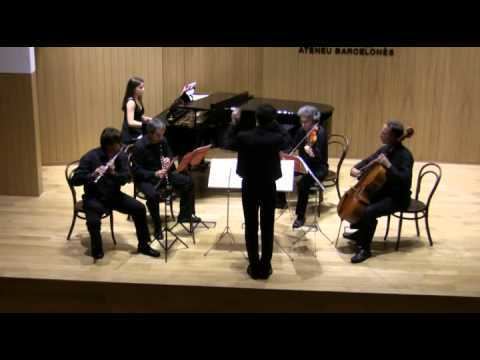A Pierrot ensemble is a musical ensemble comprising flute, clarinet, violin, cello and piano, frequently augmented by the addition of a singer or percussionist, and/or by the performers doubling on other woodwind/stringed/keyboard instruments. This ensemble is named after twentieth-century composer Arnold Schoenberg’s seminal work Pierrot Lunaire, which includes the quintet of instruments above with a female singer.
The quintet of instruments used in Pierrot Lunaire became the core ensemble for many contemporary-music ensembles of the twentieth century, such as The Fires of London, who formed in 1965 as "The Pierrot Players" to perform Pierrot Lunaire, and continued to concertize with a varied classical and contemporary repertory. This group (and others like it) began to perform works arranged for these instruments and commission new works especially to take advantage of this ensemble's instrumental colors.
While many professional chamber ensembles (such as string quartets and piano trios) continued to focus on musical literature of the 18th and 19th centuries, the Pierrot ensemble became one of the most prominent chamber ensembles in classical music of the 20th century, and continues to be popular with composers and performers today.
Doublings are often called for in music written for Pierrot ensemble. For example, in Schoenberg's Pierrot Lunaire, the flutist is asked to play piccolo, the clarinetist is asked to play bass clarinet (as in Earle Brown's "Tracking Pierrot"), or saxophone, and (much more unusually) the violinist is asked to play viola. Other common doublings might include E-flat clarinet (as in Carter's Triple Duo), alto flute, or even harpsichord (as in Maxwell Davies's Eight Songs for a Mad King).
Standing WaveBoston Musica Viva Pierrot plus percussionDa Capo Chamber Playerseighth blackbirdFires of LondonNew York New Music EnsemblePiccola Accademia degli SpecchiLunatics at LargeWhat is NoiseGreg Caffrey "These are the Clouds about the fallen Sun" (2013 Paris)Greg Caffrey "Idée Fixe II" (2008 revised 2013)Greg Caffrey "In Search of a Human Dialogue" (2014 Paris)Christina Athinodorou (1981): Aktaí pour flûte, clarinette, vibraphone, violon, violoncelle et piano (2008)Milton Babbitt: Arie da Capo (1979)Armando Bayolo: "Action Figure" (2002)Armando Bayolo: "Wide Open Spaces" (2012)Armando Bayolo: "Gestos Inútiles" (2014)Martin Bresnick: My Twentieth Century (2002) + violaEarle Brown: "Tracking Pierrot" (1992) + percussionJohn Cage: Seven (1988) + violaElliott Carter: Triple Duo (1983) + percussionChen Yi: Sparkle (1992) + 2 percussionists & double-bassSebastian Currier: Static (2003) {recipient of the 2007 Grawemeyer Award}Mario Davidovsky: Flashbacks (1995) + percussionMaurício Dottori: Elegie per il tramonto della luna (1989)Jacob Druckman: Come Round (1992)Hanns Eisler: Palmström (1926) + soprano (without piano)Mohammed Fairouz: Unwritten (2010)Manuel de Falla: Harpsichord concerto (1926) + oboe (the keyboard is the harpsichord)Morton Feldman: The Viola in My Life 2 (1970) + viola (the keyboard is a celesta)Morton Feldman: I Met Heine on the Rue Fürstenberg (1971) + percussion, sopranoMorton Feldman: For Frank O'Hara (1976) + percussionJorge Grossmann: "Siray" (2005)Gérard Grisey: Taléa (1986)Gérard Grisey: Vortex Temporum (1996) + violaStephen Hartke: "Meanwhile: Incidental Music to Imaginary Puppet Plays" (2007) + alto flute/piccolo, clarinet/bass clarinet, viola, percussionJohn Harbison: The Natural World (1986) + sopranoDorothy Hindman: Setting Century (1999)Kamran Ince: Waves of Talya (1989)David Lang: Sweet Air (1999)Fred Lerdahl: Time After Time (2000) + percussion {finalist for the 2001 Pulitzer Prize}Fabien Levy: A propos (2008)Steven Mackey: Indigenous Instruments (1989)Steven Mackey: Micro-Concerto (1999) + percussionDonald Martino: Notturno (1973) + percussion {winner of the 1974 Pulitzer Prize}Ron C. Mann: Claire Lunaire (2009) flute/piccolo, oboe/cor Anglais, viola, harp, soprano.Peter Maxwell Davies: Eight Songs for a Mad King (1969) + baritone and percussionRytis Mazulis: Canon mensurabilis (2000) + violaOlivier Messiaen: Quatuor pour la fin du temps ("Quartet for the end of time") (1940–41) - fluteIra J. Mowitz: Shimmerings (2004) + Digital Soundtrack: Alto flute/Piccolo, B-flat Clarinet/Bass Clarinet, Violin, Cello, Piano, GlockenspielTristan Murail: Winter Fragments (2000) + electronic soundsLior Navok: Sextet (1998) + percussionLior Navok: Elegy to the Future (2001)Robert Paterson: Sextet (1999) + percussionRobert Paterson: The Thin Ice of Your Fragile Mind (2004) + percussionRobert Paterson: Winter Songs (2008) + bass-baritone and percussionRobert Paterson: Hell's Kitchen (2014) + percussionRobert Paterson: Summer Songs (2016) + soprano and percussionGeorge Perle: Critical Moments 2 (2001) + percussionMel Powell: Sextet + percussionMaurice Ravel: Trois poèmes de Stéphane Mallarmé (1913) + one extra flute, clarinet, violin and viola, piccolo and bass clarinet (and vocalist).Steve Reich: Double Sextet (2007) can be performed either by Pierrot ensemble with tape or by 12 players {winner of the 2009 Pulitzer Prize}Belinda Reynolds: Coming AroundFrederic Rzewski: Pocket Symphony + percussionArnold Schoenberg: Pierrot Lunaire (1912) + mezzo-sopranoGunther Schuller: Paradigm Exchanges (1991)Salvatore Sciarrino: "Lo Spazio inverso" (1985) + CelestaRalph Shapey: Three for Six (1979) + percussionMatteo Sommacal: Counter Rotating In Vacuum (2001)Matteo Sommacal: La ragazza che dormiva sotto il letto (2009)Igor Stravinsky: Trois Poésies de Lyrique Japonaise (1913) + one extra flute, clarinet, violin and one viola.Steven Stucky: Ad Parnassum (1998)William Susman: Twisted Figures (1987) + malletsWilliam Susman: The Starry Dynamo (1994)William Susman: Camille (2010) with piano four-handsMichael Torke: Telephone Book (1995) {comprising Yellow Pages (1985), Blue Pages (1995), and White Pages (1995)}Joan Tower: Petroushskates (1980)Theo Verbey: Perplex (2004) + vibraphoneRolf Wallin: The Age of Wire and String (2005)Barbara White: Learning to See + percussionBarbara White: Life in the Castle + mezzo-sopranoBarbara White: My barn having burned to the ground, I can now see the moonJohn Woolrich In the Mirrors of Asleep (2007)Charles Wuorinen: New York Notes (1982) + 1 or 2 percussionists and electronic soundsIannis Xenakis: Plektó (1993) + percussionCarolyn Yarnell: Lapis LazuliZhou Long: Five Elements (2002) + percussion {also exists in a version with Chinese instruments}Zhou Long: Dhyana (1989)Fernando Riederer: Alento II (2011)
